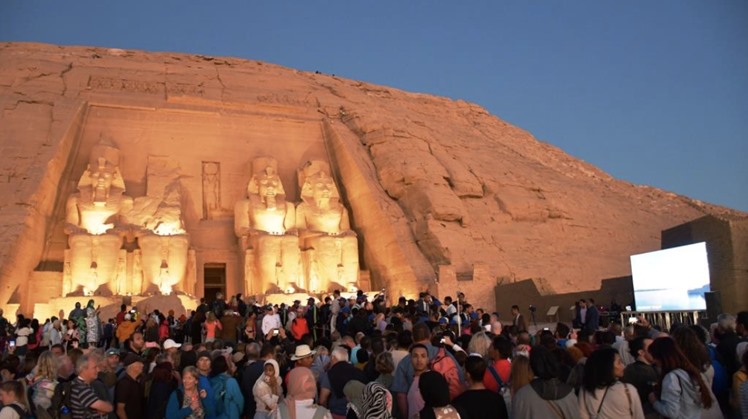The phenomenon of the sun perpendicular to the face of Ramses in the temple of Abu Simbel in Aswan is a phenomenon that a number of Egyptians and foreigners follow. At the time when the sun illuminates the face of Ramses, pioneers and visitors begin to photograph the event and follow it as a miracle that reveals the ancient Egyptians reached unique astronomical accounts recorded by a phenomenon that continues to this day, October 22 In which the sun perpendicular to the face of Ramses II.
The sun’s rays perpendicular to the “Holy of Holies” in the Abu Simbel temples twice a year, February 22 and October 22, as the sun’s rays infiltrate the temple, reaching the Holy of Holies, which is about sixty meters away from the entrance, and consists of a platform that includes the statue of King Ramses II sitting next to the statue of the god Ra Hor His sister, the god Amun, and a fourth statue of the god Ptah, and the sun does not perpendicular to the face of the statue of "Ptah", which the ancients considered the god of darkness.
The sun's rays penetrate the front corridor of the entrance to the Temple of Ramses II, with a length of 60 meters, until it reaches the Holy of Holies. The Holy of Holies consists of a platform that includes the statue of King Ramses II sitting next to him, the statue of the god Ra Hor and the god Amun and a fourth statue of the god Ptah.
The phenomenon of perpendicular sun takes 20 minutes and may reach 25 minutes, and the Abu Simbel temple was moved after it was cut to save it from drowning under the waters of the dam lake from its old site that was carved inside the mountain to its current location, and this phenomenon has been repeated on October 22 and February 22 since then With a difference of a day from what was prevalent before, it was the second perpendicular to the sun on October 21 before it was moved, due to the change in latitude and longitude after moving the temple 120 meters to the west and a height of 60 meters.
The reason behind the perpendicularity of the sun on the face of Ramses is due to two accounts, the first is that the ancient Egyptians designed the temple based on the movement of the ark to determine the beginning of the agricultural season and the harvest season, and the second is that the perpendicularity occurs twice once with the day of the birth of King Ramses II and the day of his coronation on the throne.
The phenomenon of the sun's perpendicularity was discovered in the winter of 1874, when the British writer "Amelia Edward" and her accompanying team observed this phenomenon and recorded it in her book published in 1899 entitled "A Thousand Miles Over the Nile".
 Mon, Oct. 24, 2022
Mon, Oct. 24, 2022